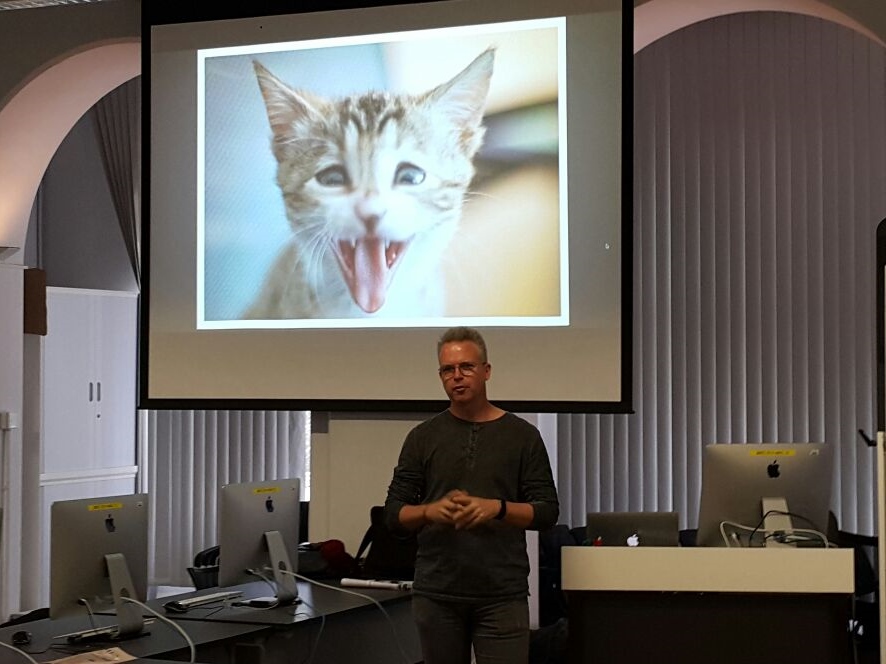
Chinese whiskers: photographing Hong Kong’s shop cats
27 March 2017
Data journalism MOOC to run again with added language support
5 April 2017Would you give your life to tell the story? Whatever your answer, JMSC professor teaches students to be ready

Not many professions ask you to put your life in danger. Journalism is one of them, and Kevin Sites, Associate Professor of Practice and former war correspondent, wants his students to be ready.
In the JMSC’s new Backpack Journalism course—which teaches students to shoot, write, edit and transmit stories without the assistance of others—Sites made sure that students were also aware of the risks of working solo.
“You have to ask yourself,” he said, during a special lecture he calls H-E-L-P (Hostile Environment Logistical Planning) at Eliot Hall on 2 March, “is the story worth my life? Sometimes it may be. But don’t risk it foolishly on a story that may not mean anything in the long run.”
Sites underscored the sacrifice journalists make with anecdotes about three colleagues he lost in Afghanistan in 2001 and the death of James Foley, a fellow alumni from Northwestern University in the US who was beheaded at the hands of the Islamic State in 2014, just two months after Sites had returned from a reporting trip in Iraq.
The H-E-L-P class learning objectives were, Sites admitted, not typical: identifying small arms fire, fixing a tourniquet and negotiating hostile military checkpoints.
 |
 |
 |
| As part of the H-E-L-P training, Sites showed students how to make an improvised stretcher from a blanket and perform basic first aid, including fixing tourniquets | ||
“I hope none of you ever encounters this in your career, but I want you to be prepared,” Sites told the students. “Any place can become a hostile environment, even the streets of Hong Kong.”
Sites showed video clips of his own students from 2014 suffering pepper spray and tear gas exposure while trying to cover the pro-democracy Umbrella Movement in the city that year.
In the case of a similar future event, he explained to students how best to cover protests, making sure to position themselves at the outside of crowds with constant assessment of wind direction and escape routes to avoid noxious gas and panicked stampedes.

The H-E-L-P training also included guidance on covering protests, such as those that occurred during the Umbrella Movement in Hong Kong, 2014
To Sites, these points aren’t just academic. He described as “the scariest moment of his life” when he was captured by militia loyal to toppled Iraqi dictator Saddam Hussein near Tikrit, Iraq, in 2003. He, along with CNN colleagues, were placed face down on the ground with AK-47 muzzles to the back of their heads.
The team’s interpreter was able to negotiate their release after a day, but Sites credits his own previous hostile environment training to helping them make the right decisions that kept the group alive.
“I want to make sure my students have the same information,” he said. “Whether they need it in the future or now. Knowledge is power. Especially when your life is on the line.”

Sites and other reporters helped to evacuate elderly civilians from Bint Jbeil, Lebanon, during a break in fighting during the Israeli-Hezbollah conflict in 2006
Shen Yiqian, a Master of Journalism student taking the course said: “I never thought that things like first aid or self-protection would be taught in a journalism course … it made me realise the dangers and challenges that journalists face, and made me think about the value and cost of reporting stories.”
Tingran Tina Tao, a fourth year Bachelor of Journalism (BJ) student, said the training “was about teaching us how to be alert and clear-minded in critical situations, instead of simply complying with journalism ethics and set rules”. “It is our own judgement whether to risk our lives for the stories that we’re heading for or not,” she said.
Su Heng, another BJ student also taking the course, said that it has helped him to independently cover news and taught him how to carry out emergency medical treatment in an extreme environment. “It has expanded my toolkit beyond the journalistic profession per se and taught me some life lessons too,” he said.
Kevin Sites is an award-winning backpack journalist and author who became the first internet correspondent for Yahoo! News. In his groundbreaking Hot Zone project, he covered nearly every war in the world in one year earning the 2006 Daniel Pearl Award for Courage and Integrity in Journalism.
See more photos from the lecture here and watch a video of how to use a blanket as an improvised stretcher for victim evacuation here.
(Feature image: Sites embedded with US and Afghan Army troops on a reporting trip in eastern Afghanistan, 2013―he’s been covering the conflict for more than a dozen years)
